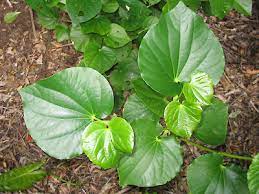Piper excelsum, commonly known as Kawakawa, is a plant native to New Zealand and belongs to the Piperaceae family. Kawakawa holds significant cultural, medicinal, and ecological importance in New Zealand’s indigenous Māori culture and traditional medicine.
Kawakawa is a shrub or small tree that typically grows in coastal and lowland forests throughout New Zealand’s North Island and parts of the South Island. It is characterized by its distinctive heart-shaped leaves, which have prominent veins and serrated edges. The leaves are glossy dark green on the upper surface and lighter green underneath.
In addition to its unique foliage, Kawakawa is recognized for its small, round fruits, which ripen from green to red and are a food source for native birds such as kererū (wood pigeons) and tui.
Culturally, Kawakawa holds special significance for the Māori people, who have utilized various parts of the plant for centuries. The leaves, in particular, are highly valued for their medicinal properties and are commonly used in traditional Māori medicine. Kawakawa leaves contain bioactive compounds such as polyphenols, which contribute to their therapeutic effects.
In traditional Māori medicine, Kawakawa leaves are often brewed into a tea or infusion and ingested to alleviate a range of ailments, including digestive issues, respiratory problems, and skin conditions. The leaves are also used topically as a poultice or salve to soothe wounds, rashes, and insect bites.
Beyond its medicinal uses, Kawakawa is also used in cultural practices and ceremonies. Māori elders often incorporate Kawakawa leaves into rituals for protection, blessing, and spiritual cleansing, recognizing the plant’s connection to the land and its healing properties.
In addition to its cultural and medicinal significance, Kawakawa plays a vital ecological role in New Zealand’s native forests, providing habitat and food for native wildlife and contributing to the overall biodiversity of the ecosystem.
Overall, Piper excelsum, or Kawakawa, is a cherished plant in New Zealand, valued for its cultural heritage, traditional medicine, and ecological importance. It serves as a symbol of resilience, connection to the land, and the enduring wisdom of indigenous knowledge.
The Botanical Description of Piper excelsum
1. Leaves: Piper excelsum, commonly known as Kawakawa, features distinctive heart-shaped leaves with a glossy green surface and prominent veins. These leaves typically grow alternately along the stems.
2. Flowers: The plant produces small, greenish-white flowers that cluster together on slender spikes. These flowers are often inconspicuous but attract pollinators like bees and butterflies.
3. Stems: Kawakawa stems are woody and can vary in thickness, with some specimens growing as small shrubs while others develop into larger trees. The bark may have a rough texture and ranges in color from brown to gray.
4. Fruits: The fruits of Piper excelsum are small, berry-like drupes that mature from green to red or black. These fruits are edible and may contain seeds inside.
5. Roots: The root system of Kawakawa is typically shallow and fibrous, aiding in anchoring the plant to the soil and absorbing water and nutrients.
6. Growth Habit: This plant exhibits a bushy or tree-like growth habit, depending on environmental conditions and available space. In favorable conditions, it can reach heights of up to several meters.
7. Aroma: When crushed or bruised, the leaves of Kawakawa emit a pleasant aroma, often described as aromatic and spicy.
8. Texture: The leaves of Piper excelsum have a smooth and slightly waxy texture, which helps reduce water loss through transpiration.
9. Size: Mature specimens of Kawakawa can vary widely in size, ranging from small shrubs of a few meters in height to taller trees reaching over ten meters.
10. Habitat: This plant is native to New Zealand and is commonly found in coastal areas, forests, and scrublands. It prefers well-drained soils and partial shade but can tolerate a range of environmental conditions.
11. Seasonality: Piper excelsum is an evergreen plant, meaning it retains its foliage throughout the year. However, it may exhibit increased growth during the warmer months.
12. Adaptations: Kawakawa has evolved various adaptations to survive in its native habitat, including chemical defenses against herbivores and mechanisms for efficient water use.
The Geographic Distribution of Piper excelsum

1. New Zealand: Piper excelsum is endemic to New Zealand, where it is distributed throughout the North Island and the northern regions of the South Island. It is particularly abundant in coastal areas and lowland forests.
2. Coastal Regions: Within New Zealand, Kawakawa is commonly found in coastal regions, including sandy beaches, dunes, and cliffs. It thrives in these environments due to its tolerance for salt spray and sandy soils.
3. Forests: The plant also occurs in various forest types, including native forests, regenerating forests, and coastal forest remnants. It can be found growing alongside other native flora species.
4. Islands: Piper excelsum may also inhabit some offshore islands surrounding New Zealand, where suitable habitat conditions are present.
5. Altitudinal Range: While Kawakawa primarily occurs at low to moderate elevations, it has been documented at altitudes of up to 600 meters above sea level in some regions.
6. Conservation Status: Despite its widespread distribution within New Zealand, certain populations of Kawakawa may face threats from habitat loss, invasive species, and browsing by introduced herbivores.
7. Ecological Role: Within its native range, Piper excelsum plays a vital ecological role as a food source for native birds and insects. Its presence contributes to the overall biodiversity of New Zealand’s ecosystems.
8. Human Interaction: Indigenous Māori people have historically used Kawakawa for various medicinal and cultural purposes, influencing its distribution and abundance in certain areas.
9. Climate Preferences: While adaptable to a range of environmental conditions, Kawakawa generally prefers mild temperate climates with adequate rainfall and humidity.
10. Habitat Fragmentation: Urbanization and land development have led to the fragmentation of Kawakawa habitat in some regions, potentially affecting its distribution and genetic diversity.
11. Restoration Efforts: Conservation organizations and government agencies in New Zealand are actively involved in habitat restoration projects aimed at protecting and enhancing populations of native plants like Piper excelsum.
The Chemical Composition of Piper excelsum
1. Alkaloids: Piper excelsum contains various alkaloids, including piperidine derivatives such as piperine and dihydropiperine. These compounds contribute to the plant’s pharmacological properties.
2. Essential Oils: The leaves and stems of Kawakawa contain essential oils rich in volatile compounds, including terpenes, sesquiterpenes, and monoterpenes. These oils contribute to the plant’s distinctive aroma and flavor.
3. Flavonoids: Flavonoids are abundant in Piper excelsum and contribute to its antioxidant activity. These compounds have been associated with various health benefits, including anti-inflammatory and immune-modulating effects.
4. Phenolic Compounds: Kawakawa is rich in phenolic compounds, such as phenolic acids and flavonols, which exhibit antioxidant and anti-inflammatory properties. These compounds may help protect cells from oxidative damage.
5. Tannins: Tannins are present in the leaves and bark of Piper excelsum and contribute to its astringent taste. These compounds have been traditionally used for their antimicrobial and wound-healing properties.
6. Lignans: Some studies have identified lignans in Kawakawa, which are polyphenolic compounds with potential health benefits, including estrogenic and antiestrogenic effects.
7. Polyunsaturated Fatty Acids: The seeds of Piper excelsum contain polyunsaturated fatty acids, such as linoleic acid and α-linolenic acid, which are essential for human health and have anti-inflammatory properties.
8. Carotenoids: Carotenoids, including β-carotene and lutein, are present in Kawakawa leaves and fruits, contributing to their yellow to orange coloration and potential health benefits as antioxidants.
9. Saponins: Saponins are glycosides found in Piper excelsum with foaming properties. These compounds have been investigated for their potential cholesterol-lowering and immune-stimulating effects.
10. Amino Acids: Kawakawa contains various amino acids, including essential amino acids necessary for protein synthesis and overall health.
11. Minerals: The plant is a source of minerals such as calcium, magnesium, potassium, and iron, which are essential for various physiological functions in the human body.
12. Vitamins: Piper excelsum contains vitamins A, C, and E, which are important antioxidants involved in immune function, collagen synthesis, and cellular protection against oxidative stress.
13. Glycosides: Some glycosides have been identified in Kawakawa, although their specific roles and pharmacological activities remain to be fully elucidated.
14. Proteins: The leaves and seeds of Piper excelsum contain proteins that serve as building blocks for tissues and enzymes essential for metabolic processes.
Read Also: 12 Medicinal Health Benefits Of Renealmia alpinia (Pink cone ginger)
The Medicinal Health Benefits Of Piper excelsum (Kawakawa)

1. Anti-inflammatory Properties: Kawakawa exhibits potent anti-inflammatory effects, making it useful for alleviating symptoms of inflammatory conditions such as arthritis and rheumatism.
2. Analgesic Effects: The plant contains compounds that have analgesic properties, providing relief from pain and discomfort associated with various ailments.
3. Digestive Support: Kawakawa has been traditionally used to support digestive health, helping to alleviate symptoms of indigestion, bloating, and stomach cramps.
4. Respiratory Support: Piper excelsum is known for its respiratory benefits, including relieving coughs, congestion, and respiratory infections such as colds and flu.
5. Skin Healing: Topical applications of Kawakawa preparations can promote wound healing, reduce inflammation, and soothe skin irritations such as rashes and insect bites.
6. Immune Enhancement: The plant contains compounds that support immune function, helping the body defend against infections and illnesses.
7. Antioxidant Activity: Kawakawa exhibits antioxidant properties, scavenging free radicals and protecting cells from oxidative damage implicated in aging and disease.
8. Adaptogenic Effects: Piper excelsum may act as an adaptogen, helping the body cope with stress and promote overall resilience and well-being.
9. Cardiovascular Support: Some studies suggest that Kawakawa may have cardiovascular benefits, including lowering blood pressure and improving circulation.
10. Anti-microbial Properties: Certain compounds found in Piper excelsum have antimicrobial activity, inhibiting the growth of bacteria, fungi, and other pathogens.
11. Anti-allergic Effects: Kawakawa may help alleviate allergic reactions by modulating immune responses and reducing inflammation associated with allergies.
12. Mental Health Support: Some traditional uses of Kawakawa include promoting mental clarity, relaxation, and emotional balance, contributing to overall mental well-being.
13. Urinary Health: Piper excelsum has diuretic properties, promoting urine production and supporting urinary tract health.
14. Hormonal Balance: Traditional uses of Kawakawa include regulating hormonal balance and menstrual cycles in women, although scientific evidence supporting these claims is limited.
15. Anticancer Potential: While preliminary studies suggest that certain compounds in Piper excelsum may have anticancer properties, further research is needed to elucidate their mechanisms of action and therapeutic potential.
16. Detoxification Support: Kawakawa has been traditionally used as a detoxifying agent, helping to eliminate toxins from the body and support liver function.
The Methods of Usage to Achieve the Provided Health Benefits Of Piper excelsum (Kawakawa)
1. Herbal Tea: Brewing Kawakawa leaves into a tea is a popular method of consumption, providing a convenient way to access its medicinal properties.
2. Topical Applications: Applying Kawakawa-infused oils, creams, or poultices directly to the skin can help address various dermatological issues and promote wound healing.
3. Tinctures and Extracts: Liquid extracts of Kawakawa are available and can be added to water or other beverages for internal use, providing a concentrated dose of its beneficial compounds.
4. Steam Inhalation: Inhaling steam infused with Kawakawa essential oil or dried leaves can help relieve respiratory congestion and promote clear breathing.
5. Culinary Use: Incorporating fresh or dried Kawakawa leaves into culinary dishes adds flavor and may offer some of its health benefits when consumed regularly.
6. Capsules and Tablets: Supplement forms of Kawakawa are available in the form of capsules or tablets, providing a convenient option for those who prefer standardized dosages.
7. Poultices: Applying mashed Kawakawa leaves directly to affected areas of the skin can help reduce inflammation, soothe irritations, and promote healing.
8. Mouthwash: Gargling with a Kawakawa-infused mouthwash can help alleviate sore throat symptoms and promote oral hygiene.
9. Bath Additives: Adding Kawakawa leaves or extracts to bathwater can soothe muscle aches and pains, promote relaxation, and support overall well-being.
10. Compresses: Applying warm compresses infused with Kawakawa decoctions can help relieve muscle tension, joint pain, and menstrual cramps.
11. Massage Oils: Mixing Kawakawa essential oil with a carrier oil and using it for massage can help relax muscles, reduce inflammation, and promote circulation.
12. Inhalation Therapy: Diffusing Kawakawa essential oil into the air using a diffuser or inhaler can help uplift mood, reduce stress, and enhance mental clarity.
13. Smoking Blends: Some individuals incorporate dried Kawakawa leaves into smoking blends for ceremonial or recreational purposes, although this method is less common due to health concerns associated with smoking.
The Side Effects Of Using Piper excelsum Medicinal Plant
1. Allergic Reactions: Some individuals may experience allergic reactions to Kawakawa, especially if they are sensitive to plants in the Piperaceae family.
2. Gastrointestinal Upset: Excessive consumption of Kawakawa tea or extracts may cause gastrointestinal upset, including nausea, vomiting, or diarrhea.
3. Skin Irritation: Topical application of Kawakawa preparations may cause skin irritation or allergic dermatitis in sensitive individuals.
4. Drug Interactions: Piper excelsum may interact with certain medications, particularly blood thinners, antiplatelet drugs, and medications metabolized by the liver.
5. Pregnancy and Breastfeeding: The safety of using Kawakawa during pregnancy and breastfeeding has not been established, and caution is advised.
6. Liver Toxicity: While rare, excessive consumption of Kawakawa or prolonged use of high doses may potentially lead to liver toxicity or other adverse effects.
7. Photosensitivity: Some individuals may experience increased sensitivity to sunlight after using Kawakawa topically, leading to sunburn or skin damage.
8. Central Nervous System Effects: High doses of Kawakawa may have central nervous system effects, including dizziness, drowsiness, or headache.
9. Blood Pressure Changes: Individuals with hypertension should use Kawakawa cautiously, as it may affect blood pressure levels.
10. Hormonal Effects: Some compounds in Kawakawa may have hormonal effects, potentially affecting hormone-sensitive conditions or medications.
11. Renal Effects: Individuals with kidney disorders should use Kawakawa with caution, as excessive consumption may affect renal function.
12. Children and Elderly: Special caution is advised when using Kawakawa in children or elderly individuals, as they may be more susceptible to adverse effects.
13. Long-Term Use: Prolonged or excessive use of Kawakawa may lead to tolerance, dependence, or other long-term health consequences.
14. Quality and Purity: Ensuring the quality and purity of Kawakawa products is essential to minimize the risk of contamination or adulteration with other substances.
Read Also: 16 Medicinal Health Benefits Of Scleromitrion diffusum (Spreading Diamond Flower)
The Scientific Research and Studies of Piper excelsum

1. Anti-inflammatory Activity: Several studies have demonstrated the anti-inflammatory properties of Kawakawa extracts, attributed to its bioactive compounds such as flavonoids and alkaloids.
2. Antioxidant Effects: Research indicates that Piper excelsum exhibits significant antioxidant activity, which may help protect cells from oxidative stress and reduce the risk of chronic diseases.
3. Anti-microbial Properties: In vitro studies have shown that Kawakawa extracts possess antimicrobial activity against a range of bacteria, fungi, and other pathogens, supporting its traditional use as a medicinal plant.
4. Wound Healing: Animal studies have suggested that topical application of Kawakawa extracts promotes wound healing by enhancing collagen synthesis, reducing inflammation, and accelerating tissue regeneration.
5. Analgesic Effects: Experimental evidence suggests that certain compounds in Piper excelsum have analgesic properties, providing relief from pain and discomfort associated with various conditions.
6. Immunomodulatory Effects: Preliminary research indicates that Kawakawa may modulate immune function, potentially enhancing the body’s ability to defend against infections and diseases.
The Safety Precautions and Recommendations In Using Piper excelsum Medicinal Plant
1. Consultation: Before using Kawakawa for medicinal purposes, it is advisable to consult with a healthcare professional, particularly if you have pre-existing health conditions or are taking medications.
2. Dosage: Follow recommended dosage guidelines when using Kawakawa preparations, as excessive consumption may lead to adverse effects.
3. Quality Control: Choose reputable sources for Kawakawa products to ensure quality, purity, and potency.
4. Pregnancy and Lactation: Pregnant or breastfeeding women should avoid using Kawakawa unless under the guidance of a qualified healthcare provider.
5. Allergy Testing: Perform a patch test before using Kawakawa topically to check for potential allergic reactions or skin sensitivities.
6. Monitoring: Regularly monitor for any adverse reactions or side effects when using Kawakawa, especially with long-term or high-dose use.
7. Interactions: Be aware of potential drug interactions when using Kawakawa concurrently with medications, and consult with a healthcare professional if in doubt.
8. Children and Elderly: Use caution when administering Kawakawa to children or elderly individuals, as they may be more vulnerable to adverse effects.
9. Duration of Use: Avoid prolonged or excessive use of Kawakawa without medical supervision, as this may increase the risk of adverse effects or complications.
10. Storage: Store Kawakawa products in a cool, dry place away from direct sunlight and moisture to maintain their stability and efficacy.
11. Labeling: Ensure that Kawakawa products are properly labeled with ingredient information, dosage instructions, and any relevant warnings or precautions.
12. Adverse Effects Reporting: Report any adverse effects or suspected reactions associated with Kawakawa use to appropriate regulatory authorities or healthcare professionals.
13. Education: Educate yourself about the potential benefits, risks, and proper usage of Kawakawa to make informed decisions about its use for health purposes.
14. Discontinuation: Discontinue use of Kawakawa if you experience any severe or persistent adverse effects and seek medical attention if necessary.
FAQs About Piper excelsum Medicinal Plant
1. Is Piper excelsum safe to use?
Yes, when used responsibly and in appropriate doses, Piper excelsum is generally considered safe for most individuals. However, it’s essential to be aware of potential adverse effects and consult with a healthcare professional if in doubt.
2. What are the traditional uses of Kawakawa?
Traditionally, Kawakawa has been used by indigenous Māori people of New Zealand for various medicinal purposes, including treating wounds, digestive issues, respiratory ailments, and skin conditions.
3. Can Kawakawa be used during pregnancy?
Pregnant women should exercise caution when using Kawakawa, as its safety during pregnancy has not been established. It’s advisable to consult with a healthcare provider before use.
4. How can I prepare Kawakawa tea?
To prepare Kawakawa tea, steep fresh or dried Kawakawa leaves in hot water for several minutes, then strain and enjoy. Honey or lemon may be added for flavor if desired.
5. Are there any contraindications for using Kawakawa?
Individuals with known allergies to plants in the Piperaceae family or those taking certain medications, such as blood thinners or liver medications, should use Kawakawa with caution and seek medical advice if necessary.
6. Can Kawakawa be used for children?
While Kawakawa is generally considered safe for children when used appropriately, it’s advisable to consult with a healthcare professional before administering it to children, especially in young or vulnerable populations.
Read Also: Complete Composting Guide for Beginners

